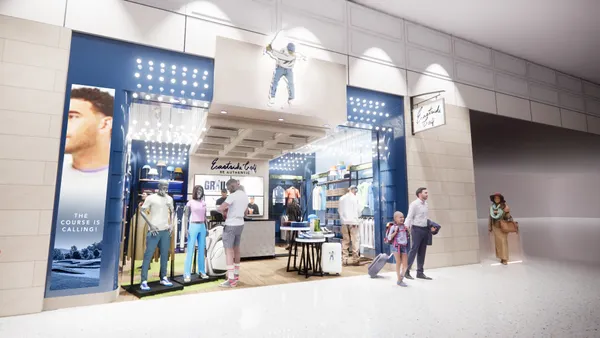This feature is part of a larger package on sustainability. The rest of the series can be found here.
It takes a certain personality to set your sights on launching a footwear brand without any experience in footwear. In Tim Brown's case, it's tied to a nose-to-the-grindstone obsession with practice and refinement — qualities that also landed him a job playing professional soccer, which he now refers to as his "accidental career."
It took roughly seven years and 200 prototypes from the time Brown first visited a footwear factory to the time he launched Allbirds in March 2016, with the seemingly basic goal of making a simple, well-designed and comfortable shoe.
While the mission was simple, though, Brown found little in the footwear market to reflect the goals he had for Allbirds' wool runners, frustrations that were in part born out of the logo-heavy marketing he experienced as a professional athlete.
"I was paid, in a smaller way than Michael Jordan, to wear product, and that product had logos," he told Retail Dive in an interview in January. "I was craving not being a billboard, and the irony was that there were lots of other people that were billboards that weren't getting paid for it."
In many ways, Brown's approach to footwear has been a simplification: Can we do less and get more out of it? His principles for building the business included simple design, comfort and sustainability — three qualities that don't come together all that often, and when they do, have become laden with misconceptions.
Comfort, for one, is not associated with great design, and sustainable products are often assumed to be lower quality, according to Brown. Simple design and comfort were Brown's personal problems with footwear, but with the inspiration of co-founder Joey Zwillinger, combating customers' conceptions about sustainability also became part of Allbirds' ethos.
"Our mission was about trying to inject sustainability into a category that we felt had largely ignored it in footwear," Brown said. "There are 20 billion shoes a year made on average and they were made not all that thoughtfully. So we saw an opportunity to do that, not just because it was the right thing to do for the environment, but because it could make better products."
That point is especially key in a retail landscape that has become increasingly focused on brand purpose, with sustainability chief among those.
A better way to make shoes
The number of companies pitching themselves as environmentally friendly, and highlighting efforts they've made to support that, is on the rise, both because consumers are showing more interest in sustainability and because (at least for some businesses) they themselves care about it.
Those companies that are serious about social responsibility often seek out third-party certifications to prove that their practices are as good as they say they are. Allbirds, for example, is a certified B Corporation — a title also held by Casper, Leesa and Grove Collaborative, among other direct-to-consumer (DTC) brands, as well as Gap-owned Athleta. The B Corp certification has become somewhat of a badge for the retailers that have it, featured prominently on e-commerce sites and frequently brought up as proof of good environmental practices. Part of the power of it lies in its independence — the job of B Lab, the company that administers the B Corp certification, is to make sure that a company is actually meeting a certain set of standards.
Anthea Kelsick, chief marketing officer of B Lab, said it's a label that benefits the retailer, but is also being used as a signal to shoppers that they're spending their money at a good company.
"Sustainability is not why people buy things."

Tim Brown
Co-founder and CEO of Allbirds
"When you're a consumer, you know that: yes, not only is the product that you're buying sustainably and socially sound, but also the company that you're buying it from, and the way they treat their workers and the way they treat their supply chain and the way they source their materials is all done in a way that's meant to impact positively the social and environmental context that they're in," she told Retail Dive in an interview.
The movement toward conscious consumerism has impacted how retailers think about their marketing — 81% of consumers want brands to take a stand on environmental issues, according to data from Sprout Social emailed to Retail Dive — but at the heart of it, it's the businesses themselves that have to be committed to doing good. Kelsick and Brown both verbalized as much, and Avedis Seferian, CEO of Worldwide Responsible Accredited Production (WRAP), which gives out certification for socially responsible factories, also noted that consumer attention only goes so far in driving real change.
"The consumer will pick up a cause and has a tendency of punishing bad actors, which is great, but generally speaking, consumers are not very good at long-term rewarding good players. They like boycotts, they like reacting against a bad actor, and those bad actors deserve that, but when another brand tries to consistently be good, it can be hard to sustain that off of consumer preferences alone," he said in an interview. "So the driving force to me still remains brands and retailers wanting to be responsible actors in the space — that's still the primary focus."
Brown recognizes that as well, and although Allbirds is a brand built on sustainability, with wool and eucalyptus fiber being two key ingredients for its products, it's also a brand built predominantly on a quality product. The wool makes for light shoes and the eucalyptus fiber has a cooling quality that makes their shoes more wearable during warm summer months — both qualities that benefit the consumer.
"We didn't start Allbirds to be a wool business or a shoe business, we started Allbirds to be a business that would be a part of what we thought was a coming revolution in the way that things were made — and that's a lofty thing to say, a harder thing to do," Brown said. "But also with the belief that sustainability is not why people buy things and that it was really important to build a brand that was about a great product, not a sustainable one."
The DTC advantage
Like many other DTC founders, Brown noticed a lack of innovation around product, but the disruption he’s driving is vastly different from that of, for example, the mattress category, which was reaping at times 900% margins on products and leaving the field wide open for startups to provide a better price and service while still making a profit. For Brown, the struggle lay in the footwear business model, built around wholesale, which meant margins that left little room for innovation.
Selling directly to consumers ultimately gave Brown and Zwillinger more room to innovate with materials, and the gamble has so far paid off: with a price point of roughly $95 per pair, the company is now valued at $1.4 billion. That comes after its latest funding round, which made the brand's total raised capital $77.5 million, according to Pitchbook data emailed to Retail Dive. One of those investors was David Gilboa, co-founder and co-CEO of Warby Parker, while Neil Blumenthal sits on Allbirds' board. Both became friends with Zwillinger while attending Wharton business school, a veritable breeding ground for founders and investors of DTC businesses.
In many ways, they've followed the traditional DTC story: Raise money, launch online and begin opening stores (Allbirds currently has five brick-and-mortar locations, according to the website). Brown actually first launched the brand on Kickstarter in 2014 with a film he shot on a family friend's sheep farm, and sold his first pair to Zwillinger. The amount of interest he got encouraged him to keep going with the product. Five years later, Brown has acknowledged physical stores are an important part of the brand's growth plan. As with most things Brown's thinking about, though, it has to fit in with the brand image they're cultivating.
That manifests itself in the details of the retailer's stores in multiple ways, including through a chair that's designed to tilt slightly, allowing shoppers to reach their shoes (and shoelaces) easier. It's made out of different materials depending on the market the store is in, and that same local touch influences many other details about the retailer's physical locations.
"There's a color story that's super important that we try to tie to the local market. At the end of the day, we're a sustainable material company at our core, so we use different materials to make the different components of the store depending on what market it is," Brown said. "It's bedrock in New York, in San Francisco it's made from old reused timber from the piers and in London, there's a different sort of execution again. Those details most people won't notice, but from the beginning, all those things add up to the sense that you have when you encounter a brand that's thinking about all the details and that they care."
While the details of the store design might feel somewhat insignificant, it adds to the cohesiveness of Allbirds' brand message — something that distinguishes them as one of the successful purpose-driven sustainability brands, according to Supriya Jain, principal at Gartner L2.
"I think Allbirds, along with other disruptors, has sort of tapped into specifically millennials' desire or kind of openness to change the value they place on products based on how much they align to their own personal values," she told Retail Dive in an interview, noting Allbirds makes information on sustainability easily accessible when historically it's been relegated to its own landing page. "If you look at an Allbirds product page, it's the first thing that you're encountered with and it feels like what you're putting your money down for."
In a sea of brands marketing their sustainability efforts, the ones that get the most out of them are consistently releasing messaging around the environment and their brand, Jain said. It's especially effective when a brand can call attention to the impacts of their environmental work, like telling customers how many gallons of water they saved by buying a product, or giving them a head's up that their packaging might be minimalist because they're trying to cut down on waste. In Jain's view, brands trying to greenwash their way into the movement can't compete with the high-touch marketing coming from businesses built on a firm sustainable message.
According to a Gartner L2 report emailed to Retail Dive, 39% of brands promoting sustainability are doing so on Instagram, compared to 31% on Facebook, 29% on their website and significantly less elsewhere. Only 6% of brands are promoting sustainability through their product pages and 4% through email. However, Jain also noted that brands who infrequently posted about sustainable or environmental messages on social media received less engagement on those posts, but for brands where it was a more regular element of their messaging, the posts were more successful.
In a word, it all comes down to authenticity. Brown is hyper-aware of his past as a professional athlete and, with it, of the ineffectiveness of marketing that isn't a natural extension of the brand, whether that's celebrity endorsements or brand purpose.
"There's a graveyard of athletes that have just assumed they can put their name to something — and far, far bigger, greater celebrated athletes than me — with the assumption that was going to work," he said. "Probably much like sustainability, I think at the end of the day, you can put labels and names on things, but at the end of the day it's about a product and a product experience."
The 'Woolies' that wasn't
While sustainability certainly feels like an authentic message coming from Allbirds, it's also much easier for small companies to tell those stories consistently, according to Jain. She pointed to both Everlane and Allbirds as two companies including detailed visuals on their website and product pages that point to their sustainable roots, something that isn't as easy to do for larger businesses.
"They're not working with a lot of product, so they're able to create really what feels like a luxury online experience with a very small product assortment. Something as simple as, while you're navigating Allbirds.com and you're in their menu, you can see the visual of every single shoe product that they offer," she said, pointing to product imagery and user-generated content features that bolster that storytelling. "They have the advantage of not having to do this across a massive product assortment, so they can get it right with just a few products."
While controlling a consistent brand image on its own channels, Allbirds has also been careful about selecting brand partners and, according to Brown, they've rejected the vast majority of opportunities to collaborate, settling on a few with the likes of Nordstrom, Outdoor Voices and Shake Shack. Most recently, Allbirds partnered with the National Audubon Society to create a limited-edition collection highlighting several species of birds endangered by climate change.
In addition to working with businesses that Brown feels share a similar ethos to Allbirds, he has also been selective about only entering partnerships where the startup's team can learn something new and avoiding partnering with bigger, "cooler" companies just to spread awareness about the brand.
While Allbirds has some core principles it's adhering to for marketing purposes, the game changes slightly for larger companies. That's not to say marketing efforts can't grow as the company does. One need only look at Patagonia and REI to see that bigger companies are perfectly capable of building a brand image on sustainability, but Allbirds' strategy will likely have to change as the business scales — and Brown has every intention of scaling it.
"From the beginning, we'd always imagined the brand as being bigger than just the one sneaker that we sold. I think if we hadn't, we would have called this thing 'Woolies' and just sort of called it a day," he said, adding that the brand's vision is much larger than that.
"Where we take that is something that we're thinking a lot about and keeping pretty close to our chest, but I think there's a lot of different opportunities and we've just got to work out what are the best ones for us."
The Series
- Podcast
Conversational Commerce: How one digitally native brand baked sustainability into its DNA
- Climate
Clouds on the horizon: What climate change means for retail
- Packaging
Uncontained: The complex link between retail and packaging
- Sourcing
True blue: Denim has to change to save the planet
- Circular Economy
Temporary living: The rise of furniture rental














